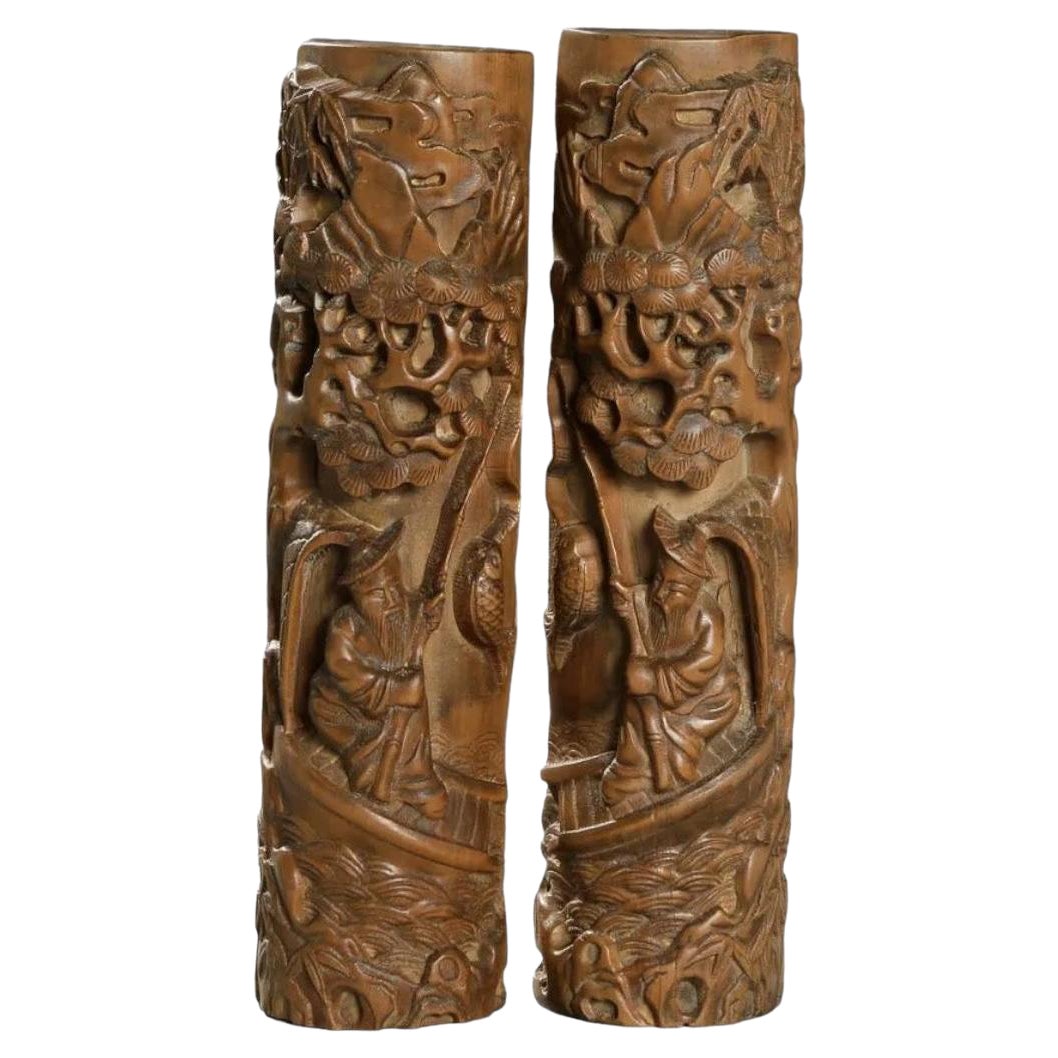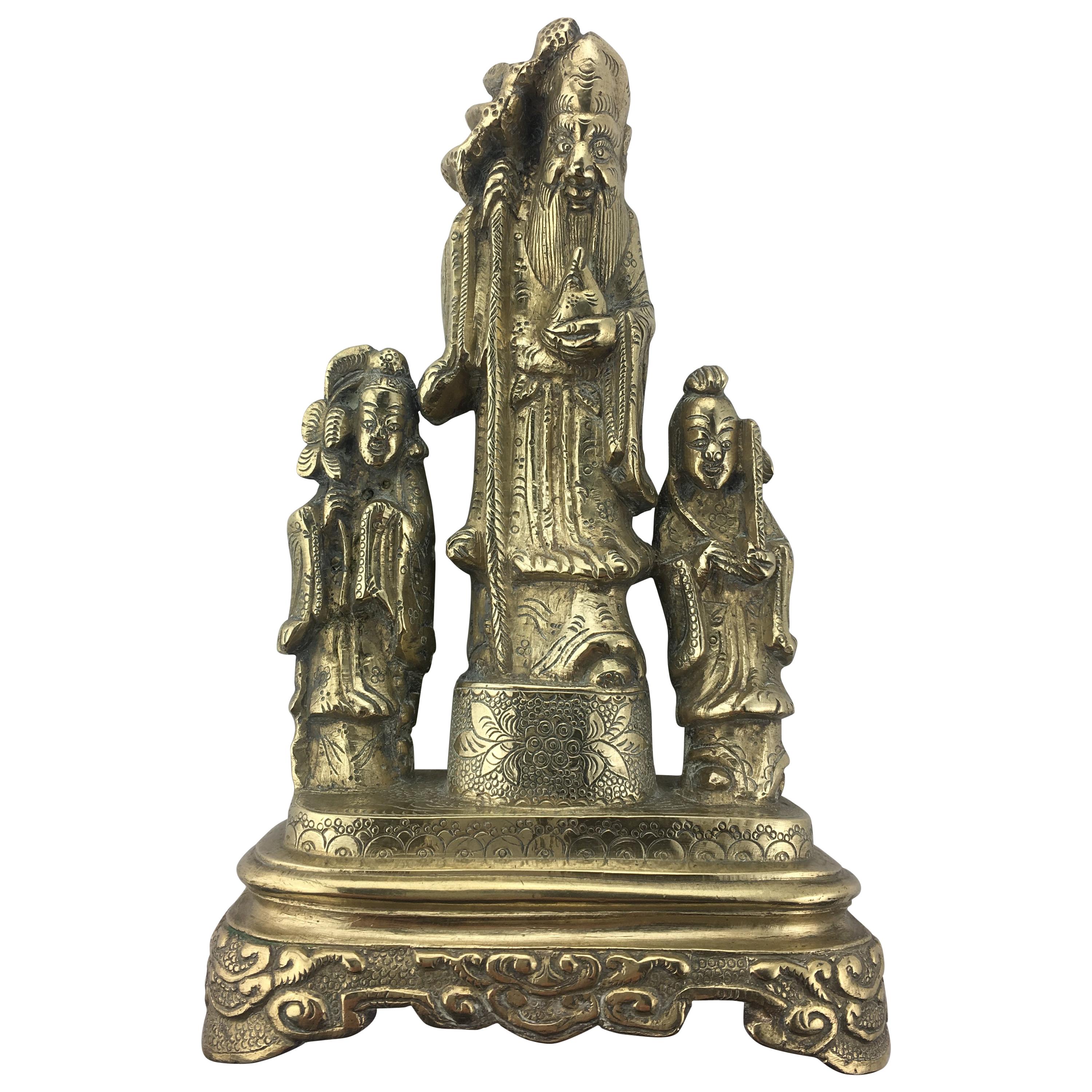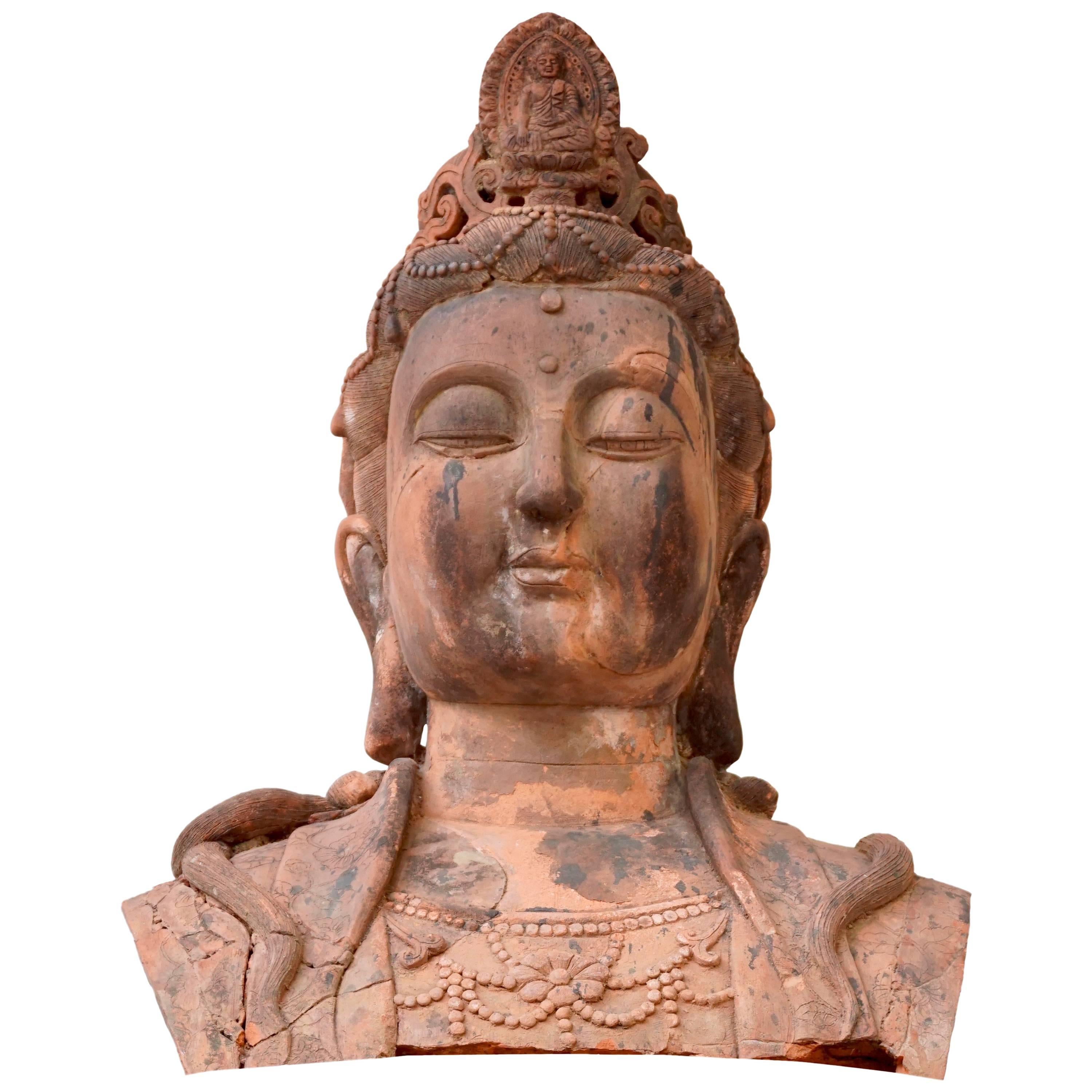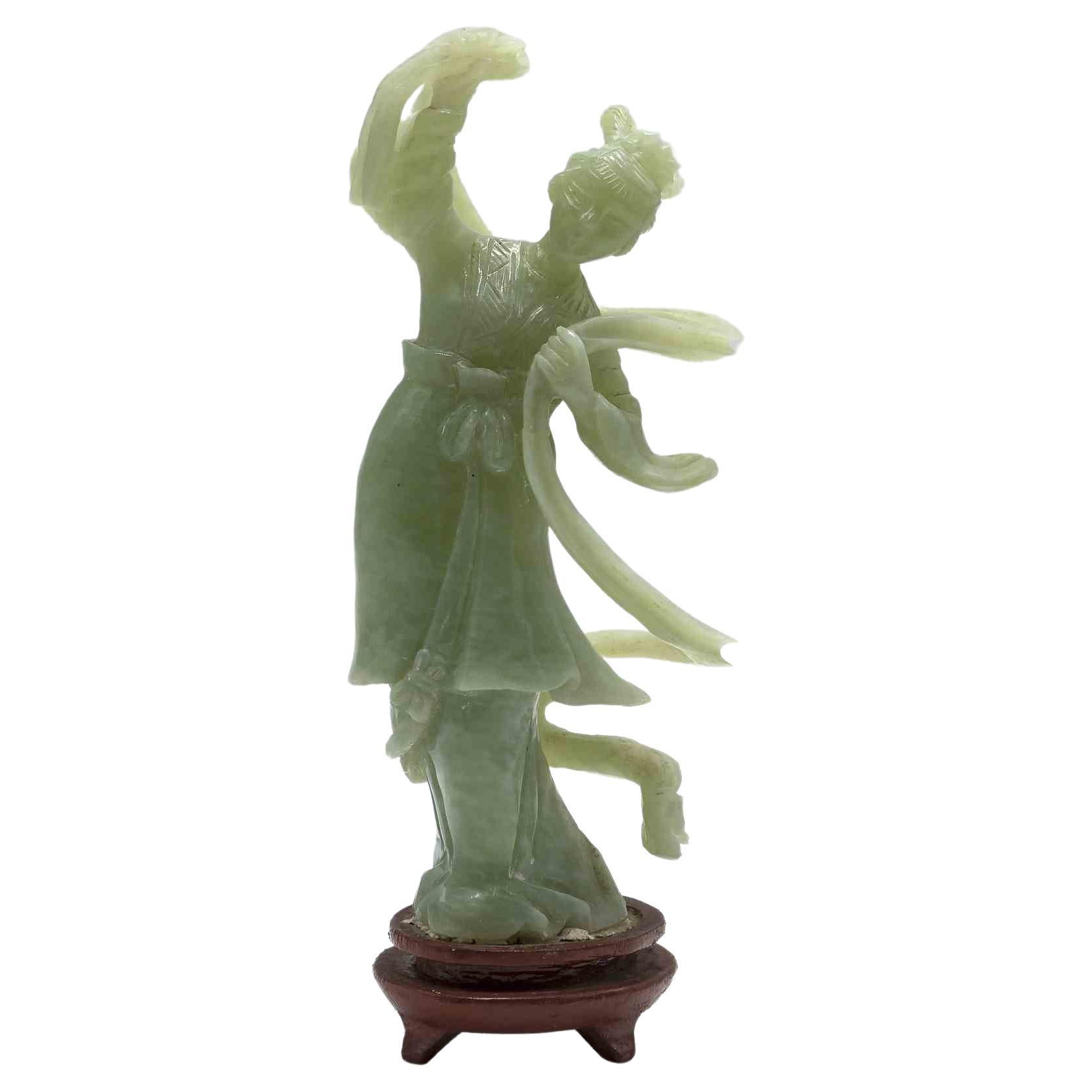Items Similar to Pair of Chinese Bronze Deity Figures, 20th Century
Want more images or videos?
Request additional images or videos from the seller
1 of 16
Pair of Chinese Bronze Deity Figures, 20th Century
About the Item
Pair of Chinese bronze figures of deities standing on dragons. The two sculptures were made in the 20th century. They represent the Tao gods Lu Xing and Fu Xing. They stand for fortune and prosperity. Very decorative sculptures with a love for detail.
The bronze is oxidized on some parts of the figures.
Bronze will oxidize when exposed to air, developing a patina coating. A brown, black, red or blue to green coating on bronze is a sign of normal, harmless corrosion. This outer layer protects the inner layers of the bronze object from deteriorating.
The sculptures are quite heavy.
- Dimensions:Height: 21 in (53.34 cm)Width: 8.5 in (21.59 cm)Depth: 12.5 in (31.75 cm)
- Sold As:Set of 2
- Style:Chinese Export (Of the Period)
- Materials and Techniques:
- Place of Origin:
- Period:1980-1989
- Date of Manufacture:1980
- Condition:Wear consistent with age and use. In good condition. Bronze oxidized.
- Seller Location:Belmont, MA
- Reference Number:1stDibs: LU1772220275662
About the Seller
5.0
Gold Seller
These expertly vetted sellers are highly rated and consistently exceed customer expectations.
Established in 2013
1stDibs seller since 2015
233 sales on 1stDibs
Typical response time: 2 hours
- ShippingRetrieving quote...Ships From: Belmont, MA
- Return PolicyA return for this item may be initiated within 2 days of delivery.
More From This SellerView All
- Meissen Porcelain Figurine 20th CenturyLocated in Belmont, MAMeissen porcelain figurine of a man selling pastry, Germany, circa 1920. One of the street sellers of Paris series (Cries de Paris) origina...Category
20th Century German Baroque Figurative Sculptures
MaterialsPorcelain
- Henri Collomb, French Artist 20th Century, “Couple Dansant”Located in Belmont, MAHenri Collomb, French artist (1905-?), “Couple Dansant” (Dancing couple), walnut hand carved. The sculpture has a monogram and is dated 192... It ships from Germany. Henri Col...Category
Vintage 1920s French Modern Figurative Sculptures
MaterialsWalnut
- Henri Collomb, French Artist 20th Century, “Nu Féminin Allongé”Located in Belmont, MAHenri Collomb, French artist (1905-?), “Nu féminin allongé (Lying female nude), walnut hand carved. The sculpture has a signature. It ships from Germany....Category
Vintage 1920s French Modern Figurative Sculptures
MaterialsWalnut
- Pair of Belgium Bronze Busts by Georges Van Der StraatenBy Georges Van der StraetenLocated in Belmont, MAThe Belgium artist Georges van der Straaten (born 1856) designed the two bronze busts at the end of the 19th century. One is titled "Bergere" (shepherdess), the other one "Pierette"....Category
Antique 1890s Belgian Aesthetic Movement Busts
MaterialsBronze
- Pair of Bronze Candelabras, France, 19th CenturyLocated in Belmont, MAPair of bronze candelabras, France 19th century. The Historicism candelabras have 7 candleholders. They are decorated with rocaille, lattice...Category
Antique 1870s French Napoleon III Candelabras
MaterialsBronze
- Porcelain Figure, Meissen, 19th CenturyLocated in Belmont, MAMeissen porcelain figure of a faun with her child. The child is sitting on a small chair while his mother is offering him to drink from a horn. Beautiful figure with passion for deta...Category
Antique 1880s German Baroque Figurative Sculptures
MaterialsPorcelain
You May Also Like
- Early 20th Century Pair of Chinese Wood Carving SculpturesLocated in North Miami, FLPresenting an exquisite pair of early 20th-century Chinese wood carvings that exude artistry and cultural richness. These masterfully crafted piece...Category
Early 20th Century Chinese Sculptures and Carvings
MaterialsWood
- Bronze Chinese Statue of Three FiguresLocated in Miami, FLFinely detailed antique bronze of three Chinese figures with a wonderful patina. A beautiful and bold conversation piece for any home. Measures: 7 3/4" H x 5" W x 2 3/4" D Delightfu...Category
Antique 19th Century Chinese Figurative Sculptures
MaterialsBronze
- Larger Than Life Terracotta Buddha Bust of Guanyin, Early 20th Century, ChinaLocated in Antwerp, BEA massive larger than life terracotta buddha bust of Guan Yin, China, early 20th century. Broken and restored with wear and tear from enduring exposure to the elements. Size: 75 cm high. Weight: 40 kg. Guanyin, Kwanyin, Guanshiyin or Guanyin Pusa is the Chinese interpretation of the bodhisattva Avalokiteśvara (the goddess of comfort and mercy). In addition, she is seen in Taoism as an immortal. The scripture dedicated to her is Dabeizhou. Guanyin is the goddess of compassion and the sea. She is one of the three saints of the western paradise, along with Mahasthamaprapta and Amitabha Buddha; they are worshiped to save departed loved ones from hell and grant them entrance to the western paradise. Guanyin Chinese name Traditional Chinese 觀音 Simplified Chinese 观音 Transcriptions Full Chinese name Traditional Chinese 觀世音 Simplified Chinese 观世音 Literal meaning "[The One Who] Perceives the Sounds of the World" Transcriptions Second alternative Chinese name Traditional Chinese 觀自在 Simplified Chinese 观自在 Literal meaning "Lord who Gazes down on the World" Transcriptions Burmese name Burmese ကွမ်ယင် IPA [kwàɴ jɪ̀ɴ] Tibetan name Tibetan སྤྱན་རས་གཟིགས Vietnamese name Vietnamese alphabet Quan Âm (Quán Âm) Quán Thế Âm (Quan Thế Âm) Quán Tự Tại Chữ Hán 觀音 觀世音 觀自在 Thai name Thai กวนอิม, พระอวโลกิเตศวรโพธิสัตว์ RTGS Kuan Im, Phra Avalokitesuan Korean name Hangul 관음, 관세음, 관자재 Hanja 觀音, 觀世音, 觀自在 Transcriptions Mongolian name Mongolian script ᠨᠢᠳᠦ ᠪᠡᠷ ᠦᠵᠡᠭᠴᠢ Japanese name Kanji 観音, 観世音, 観自在 Hiragana かんのん, かんぜおん, かんじざい Transcriptions Indonesian name Indonesian Kwan Im, Kwan She Im, Awalokiteswara Filipino name Tagalog Guanyin (ᜄᜓᜀᜈᜌᜒᜈ) Sanskrit name Sanskrit अवलोकितेश्वर (Avalokiteśvara) Khmer name Khmer អវលោកិតេស្វរៈ (Avalokitesvarak), អវលោកេស្វរៈ (Avalokesvarak), លោកេស្វរៈ (Lokesvarak) Hmong name Hmong Kabyeeb, Niam-Txiv Kabyeeb, Dabpog, Niam-Txiv Dabpog Guanyin (traditional Chinese: 觀音; simplified Chinese: 观音; pinyin: Guānyīn) is a Bodhisattva associated with compassion. She is the East Asian representation of Avalokiteśvara (Sanskrit: अवलोकितेश्वर) and has been adopted by other Eastern religions, including Chinese folk religion.[note 1] She was first given the appellation "Goddess of Mercy" or "Mercy Goddess" by Jesuit missionaries in China.[1] Guanyin is short for Guanshiyin, which means "[The One Who] Perceives the Sounds of the World."[2] On the 19th day of the sixth lunar month, Guanyin's attainment of Buddhahood is celebrated.[3] Some Buddhists believe that when one of their adherents departs from this world, they are placed by Guanyin in the heart of a lotus, and then sent to the western pure land of Sukhāvatī.[4] Guanyin is often referred to as the "most widely beloved Buddhist Divinity"[5] with miraculous powers to assist all those who pray to her, as is mentioned in the Pumen chapter of Lotus Sutra and Kāraṇḍavyūha Sūtra. Several large temples in East Asia are dedicated to Guanyin, including Shaolin Monastery, Longxing Temple, Puning Temple, Nanhai Guanyin Temple, Dharma Drum Mountain, Kwan Im Thong Hood Cho Temple, Shitennō-ji, Sensō-ji, Kiyomizu-dera, Sanjūsangen-dō, and many others. Guanyin's abode and bodhimaṇḍa in India is recorded as being on Mount Potalaka. With the localization of the belief in Guanyin, each area adopted their own Potalaka. In Chinese Buddhism, Mount Putuo is considered the bodhimaṇḍa of Guanyin. Naksansa is considered to be the Potalaka of Guanyin in Korea. Japan's Potalaka is located at Fudarakusan-ji. Tibet's Potalaka is the Potala Palace. Vietnam's Potalaka is the Hương Temple. There are several pilgrimage centers for Guanyin in East Asia. Putuoshan is the main pilgrimage site in China. There is a 33 temple Guanyin pilgrimage in Korea which includes Naksansa. In Japan, there are several pilgrimages associated with Guanyin. The oldest one of them is the Saigoku Kannon Pilgrimage, a pilgrimage through 33 temples with Guanyin shrines. Guanyin is beloved by most Buddhist traditions in a nondenominational way and found in most Tibetan temples under the name Chenrézik (Wylie: Spyan ras gzigs). Guanyin is also beloved and worshipped in the temples in Nepal. The Hiranya Varna Mahavihar located in Patan is one example. Guanyin is also found in some influential Theravada temples such as Gangaramaya Temple, Kelaniya and Natha Devale nearby Temple of the Tooth...Category
Early 20th Century Chinese Chinese Export Sculptures and Carvings
MaterialsTerracotta
- 20th Century Chinese Cork Diorama, 1950sLocated in LEGNY, FRBeautiful 20th century rectangular Chinese Cork diorama. Finely carved decoration in its glass case and black lacquered base. Careful and delicate work ...Category
Vintage 1950s Chinese Figurative Sculptures
MaterialsCork
- Chinese Soapstone Fish Carving 20th CenturyLocated in Islamabad, PKChinese Soapstone fish carving 20th century. This exquisite soapstone sculpture is a unique carving, as it shows to us the natural formation of two stones with the grey soapstone accompanied by the red, yellow and beige soapstone carved into a beautiful depiction of fish and and underwater coral. Shoushan stone...Category
20th Century Chinese Ming Figurative Sculptures
MaterialsSoapstone
- Vintage Chinese Serpentine Sculpture, China, Early 20th CenturyLocated in Roma, ITVintage Chinese serpentine sculpture is a traditional decorative object realized in china in the early 20th century. Serpentine m...Category
Early 20th Century Japanese Figurative Sculptures
MaterialsMarble, Serpentine
Recently Viewed
View AllMore Ways To Browse
Bronze Objects
Bronze Figures
Chinese Chinese Bronze
Chinese Bronze
China Bronze
Chineses Bronze
Chinese Bronzes
Chinese Figures
Pair Black Chinese
Bronze Parts
Chinese Standing
Sculptures Made In China
Chinese Bronze Gold
20th Century Bronze Figures
Chinese Air
Chinese Gold Green
Green And Gold China
Chinese Stand Pair





